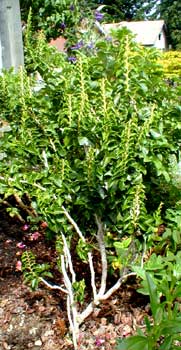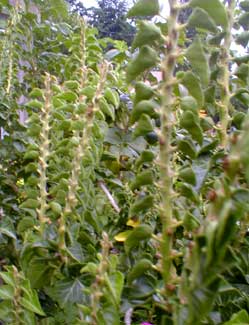
Bush Ivy; aka,
Tree Ivy
"Mares eat oats and does eat oats
& little lambs eat ivy
A kid'll eat ivy too, wouldn't you?"
-Milton Drake,
1943
1943
The so-called Tree Ivy, or Bush Ivy, has the form of an upright branching shrub resembling a leafy candalabrum. It is in reality only a mature form of the common English Ivy, Hedera helix. When grown in shady places, English ivy rarely develops the tree-ivy branches with smaller leaves having fewer lobes. An old ivy grown in a great deal of sun, however, will literally change genetically in order to produce upright branchings that emulate free-standing shrubs, & only on such parts of the ivy do flowers occur. These strongly upright branchings cease altogether the expected trailing & climbing habits.
 Ivy often lives for decades without maturing into an upright shrub or tree ivy. Vines that do not transform will never flower or set fruit. When the change does happen, the genetic transformation is irreversible; the upright portion of the ivy will never change back into a trailing ivy, & if rooted separately will develop over time into a large upright shrub.
Ivy often lives for decades without maturing into an upright shrub or tree ivy. Vines that do not transform will never flower or set fruit. When the change does happen, the genetic transformation is irreversible; the upright portion of the ivy will never change back into a trailing ivy, & if rooted separately will develop over time into a large upright shrub.Growers either root cuttings of a permanantly transformed shrubbing ivy, or graft parts of it onto the rootstock of regular trailing ivy, producing "young" tree ivys for the nursery trade. The commonest tree ivies on the market are 'Congesta' & 'Conglomerata.'
'Conglomerata' is a sterile heirloom dating to earlier than 1870, noted for round-lobed leaves that are small & curly, forming candalabrum that are somewhat flattened front & back, having the leaves lined up on only two sides of each branch. 'Congesta' has smaller triangular half-folded leaves, likewise with a compressed or flattened appearance to each upright branch.
'Erecta' is often used as a generic name for all upright adult ivies, sometimes distinguished as 'Conglomerata Erecta' or 'Congesta Erecta.' But some growers offer 'Erecta' as a distinct cultivated form that purportly grows a bit faster than average for slow-growing tree ivies. Supposing "Erecta" really is a third strain, these three varieties are sterile, so will never produce flowers then fruit that can invade surrounding woodlands. This makes "Congesta," "Conglomerata," or "Erecta" vastly preferable to fertile tree-ivies.
Vegetative propogation of these three sterile ivies is difficult for the amateur gardener. Even when successful, new plants started off the sterile varieties often results in short spreading shrubs known as Humpty Dumpty Ivy, neither vining nor with the tree-like appearance, but interesting in their own right.
The natural, fertile tree ivy is sold as 'Arborescens,' which shouldn't be planted because of the danger it can pose seeding into temperate woodlands. Other varieties of H. helix tree-ivys include the silvery-variegated 'Iceberg' which is the morphed mature version of 'Glacier,' & 'Treetop' the morphed form of 'Pittsburg.' There are not a great many named varieties since most of the fancier vining ivies are difficult to impossible to induce to go through the change in marketable numbers, even though theoretically just about any cultivar could go through this transformation, the trailing 'Gold Heart' being an example that more easily morphs into tree-ivy.
Other named cultivars include 'Garnet,' 'Poetica,' & 'Peppermint.' Because such varieties are fertile they again should not be planted in regions where ivies may seed into the wild, leaving 'Conglomerata' & 'Congesta' the better choices. There are also some rarely offered variegated forms such as 'Conglomerata Goldheart,' 'Conglomerata White Diamond,' & others that by their names would seem to be derived from the original curly-leafed 'Conglomerata,' but I do not know whether or not they are sterile like regular 'Conglomerata.'
Our tree ivy was given to us without any labeling, but it is pretty obiously 'Congesta,' a recipient of the Award of Garden Merit. Though noted for slow growth, ours took off growing right away, so that I didn't regard it as particularly slow at all. It is somewhat a dwarf, rarely taller than four feet & often only three, vs six feet or even taller for, say, 'Peppermint' or 'Arborescens.'
A local nurserywoman had overstocked these & her spares were soon rooting through the bottom of the pots & deep into the ground. I'd one day purchased several things, & she threw in a tree ivy for free, after tugging the hell out of it to get the pot loose from the ground.
I put it in a harsh spot I had only just prepared for rugosa roses. The first photo shows it in June, the second closer in snapped in September (2004).
Tree ivys are drought-tolerant & salt-spray tolerant, liking conditions identical to those for rugosa roses. The root system, however, is more delicate than for youthful trailing ivy, so a tree ivy should not be transplanted once it is established in the garden. They can be placed in full sun, but since they never revert to trailing behavior, they can also be placed in partial shade & will do just as nicely. It would be a very bad idea to plant a fertile tree ivy, because they do seed into the natural environment. Fortunately there are sterile cultivars of tree ivy.